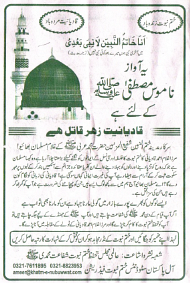Asian Human Rights Commission — Statement |
PAKISTAN: Blasphemy laws — Stopping the rot |
AHRC-ETC-040-2010
November 16, 2010
The introspection, debate and outrage generated a month ago by the attacks on two villages in Gojra on July 31 and Aug 1 may be out of public sight, as happened all too often in the past, but the nine people murdered and the homes and churches gutted are not out of mind. Neither is Najeeb Zafar, the young factory owner in Sheikhupura, Punjab, killed on August 4 for allegedly desecrating Quranic verses when he removed a calendar from a wall. The following day, police in Sanghar, Sindh, saved a similarly accused 60-year old woman, Akhtari Malkani by taking her in protective custody.
On the surface, these incidents were motivated by passions aroused by allegations of blasphemy or disrespect to the holy Quran. These criminal charges can be punishable by death – but this is a punishment for the state to administer, not private citizens. The real motivation remains settling scores, a pattern identified over twenty years ago when the first ‘blasphemy murder’ took place; that of the Punjabi poet and teacher Naiamat Ahmar in Faisalabad in 1992.
The pattern involves one party targeting another, alleging blasphemy while the real motives are personal enmity or economic rivalry as Zubeida Mustafa noted in a recent column. The accused tend to be poor people who have improved their lot in life, triggering jealousies. Accusations of blasphemy are used to justify the violence. Ms Mustafa also pointed to (mis) education as a factor that makes it easy, when such an allegation is levelled, to rabble-rouse a mob into violence.
The three recent cases bear out these observations. In Gojra, evidence points to a pre-meditated plan aimed at clearing out the village from the area, while the administration turned a deaf ear to the warnings and pleas of observers. A disgruntled employee accused Najeeb Zafar of disrespecting the Quran; the unarmed police sent to protect him could only watch as the mob set upon him. Akhtari Malkani had a monetary dispute with her accuser but disappeared without registering an FIR. She says she threw a book of accounts on the floor, not the holy Quran.
Last April, there was the horrific case of Jagdish Kumar, the young Hindu factory worker in Karachi, lynched by co-workers for alleged blasphemy. The real reason appears to have been personal enmity based on Kumar’s reported association with a Muslim girl.
Such cases have been taking place since the option of life imprisonment under Section 295-C of the Pakistan Penal Code (“Use of derogatory remarks, etc., in respect of the Holy Prophet”), the ‘blasphemy law’, introduced by Gen. Ziaul Haq in 1985 was amended by default in 1992 to make death the mandatory punishment for anyone convicted under this law. Certainly, the law does not provide for these extra-judicial murders. However, it is equally true no such murder took place until death was made the mandatory punishment for 295-C convictions.
People of all faiths, including Muslims (remember the Muslim religious scholar lynched in Gujranwala, 1994?), have been accused and attacked since then. Investigations into blasphemy accusations indicate pre-meditation rather than the heat of passion. Those who commit the violence may be arrested but none has ever been punished. Even the Inquiry Commission Tribunal headed by Justice Tanvir A. Khan of the Lahore High Court examining the destruction of Christian homes and churches in Shantinagar, 1997, was quashed (the Punjab Chief Minister then too was Shahbaz Sharif; will he rise to the occasion this time?).
The public defamation of blasphemy victims is a key tactic preceding such attacks – posters and mosque loudspeakers are routinely used for this.
Naimat Ahmar was killed after posters cropped up warning people that a Christian teacher (Ahmar) was leading their children astray. A handwritten copy in Urdu that I saw at the time warned Muslims that Ahmar was misleading students, telling them that the Prophet (pbuh) ‘stole’ goats – ‘bakriyaN charaya kartey thay’. Replace ‘churaya’ (stole) with ‘charaya’ (grazed) and it’s apparent what Ahmar probably said.
A youngster from the militant outfit Anjuman-e-Sipah-e-Sahaba (later changed to Sipah-e-Sahaba Pakistan) accosted Ahmar outside the Education Department in Faisalabad and knifed him to death. Investigations revealed that the murderer’s uncle wanted Ahmar’s job in the Education Department. The allegation of blasphemy alone was enough to ‘justify’ the murder. Policemen at the lockup housing the murderer, garlanded by his ASS (sic) mentors, embraced and kissed him. The ASS was, in fact, behind just about every ‘blasphemy case’ during the 1990s – the SSP, now banned, is believed to be behind the Gojra carnage as well.
Blasphemy accused are attacked and murdered even in prisons and police lock-ups, sometimes by the very people who are supposed to protect them. In 2004 a police constable attacked Samuel Masih, 27, a prisoner under trial at Kot Lakhpat jail with a brick-cutter. Samuel had been charged with spitting at the wall of a mosque (Section 295, “defiling a place of worship with the intent of insulting the religion of any class”, maximum sentence up to two years). He succumbed to his injuries the following day. “I wanted to earn a place in heaven by killing him,” Ali reportedly confessed.
The fanatical and misguided mindset cultivated over the past few decades will not disappear by simply repealing 295-C, although this must be done. Embarking on a sensible education policy is also a long-term step that must be taken to stop the rot. What must be an immediate priority is the strict enforcement of law and order.
Those inciting violence and murder from mosque loudspeakers and public accusations, true or false, must be held culpable, charged, tried and punished according to law. This also goes for those who desecrate a holy book or symbol of any religion. There must be accountability for those who allow these murders to take place. The political leadership is responsible for providing police with the training, means and the orders to prevent such violence. Finally, religion cannot be used or allowed to justify murder.
The views shared in this article do not necessarily reflect those of the AHRC, and the AHRC takes no responsibility for them.
About the Author:
The writer is a freelance journalist and documentary filmmaker. Ms. Sarwar’s email address is beena.sarwar@gmail.com
# # #
About AHRC: The Asian Human Rights Commission is a regional non-governmental organisation monitoring and lobbying human rights issues in Asia. The Hong Kong-based group was founded in 1984.








